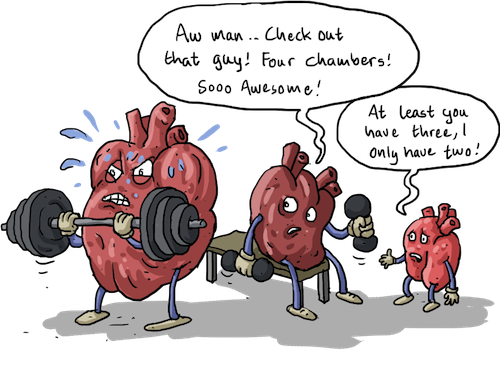Tired of ads?
Join today and never see them again.
Advertisement - Guide continues below
Why did the chicken cross the road?
Well, probably to demonstrate its bipedal movement, speed up its four-chambered heart, fill up its air sacs, score some nutrients, and get out of the sun to maintain its body temperature.
What! You've never heard that one? Trust us, a chicken is never JUST trying to get to the other side. Animals might seem simple, but they are super complex.
Animal movement alone is an amazing feat. Picture your favorite animals and think about all of the different ways they can move. Animals can thrive in the water, in the air, or on land. The only sure thing about animal movement is that almost anything is possible! Sharks fly through the water with dynamic lift, squirrels glide from the treetops, and sessile mollusks move by…well, they actually stay pretty much in one place, but even that is really neat and unique.
While animals might move in completely unique ways on the outside, on the inside their blood moves in similar ways. One of the most complex processes in animals is the transportation of blood which brings oxygen and nutrients to the cells. Circulatory systems can be: open or closed. Arthropods and mollusks have an open-circulatory system; whereas, fish, amphibians, reptiles, birds, and mammals are all members of the closed-circulatory system club. Fish pump blood with a two-chambered heart, amphibians and reptiles with a three-chambered heart, and birds and mammals with a four-chambered heart. Now, that's a hearty helping of circulatory system knowledge!

The circulatory system would be extremely unhelpful without its partner in crime, the respiratory system. Don't worry, it's a breeze. Well, maybe not if you are a fish that breathes underwater, or a salamander that breathes through its skin. Animals have evolved varying ways to exchange the gases that every cell needs for cellular respiration. Oxygen needs to go in, and carbon dioxide needs to come out. Mammals, reptiles, birds, and amphibians all breathe through their lungs, fish can collect oxygen using their gills, and insects are filled with a tiny network of tubes which carry oxygen to all of their cells.
Speaking of gas exchange, it is only a small part of a larger regulatory process called homeostasis. Animals need to regulate nearly everything in their bodies in order for all cells to work properly, and each animal has a certain neutral state at which it strives to remain. If one piece of the puzzle is missing, the rest of the pieces don't matter. Solute levels, water levels, pH levels, temperature levels, and gas levels are all of vital importance. Literally. Do you think puppies and kittens are heartwarming? Well, you are right! They are endotherms who create their own body heat.
Do you think that spiders and snakes are not heartwarming? Right again! Arthropods, reptiles, and amphibians are ectotherms who receive their body heat from external sources. In order to keep at a suitable internal body temperature, they rely on their environment heavily for gaining or shedding body heat. Endotherms rely more on themselves than their environment, and don't they have the metabolism to prove it! Doesn't just thinking about how much energy they spend in the winter make you shiver?
In this chapter we will bite into all things animal. Hold on tight, you are about to enter the wild kingdom.
Dinosaur Breath
Before dinosaurs could have terrifying roars, they had to first be able to breathe. Learn how scientists believe they did so by studying amphibian and reptile respiration.
Learn How To Hibernate
Science daily is the frontier of science. The advanced article gives a glimpse into how animal hibernation studies are putting us just a hair away from human application.
The Biology Dictionary
Have a common case of biology word befuddlement? Try biology-online.com's dictionary. The entry for homeostasis is a primo example.
Heart Works
As Captain Planet knows, heart is one of the most important powers. Howstuffworks teaches us more about this powerful organ that powers the human circulatory system.
Naked Scientists
The Naked Scientists (not actually a scientist baring it all) answer a burning question from a freezing Russian about thermoregulation.
Free Willy and Osmoregulation
Marine animals are constantly surrounded by a liquid that could kill them. Not to be overdramatic or anything. Milos Radakovich does a better job keeping his cool while he discusses osmoregulation.
Climbing Walls Using Biology
Biologist Robert Full studies crazy (and somewhat creepy) critters. TED talks are full of jaw-dropping information and this video is no exception. Full's studies of cockroaches and geckos are helping to engineer the next generation of robots that will climb walls so well that they will make Spiderman blush.
The Secret Life of Birds
The science ninjas at NOVA hit you with knowledge bombs about how bird flocks and schools of fish naturally emerge and how this could help explain the origin of consciousness and even life itself. Deep stuff.
If Cheetah Beats Greyhound, Does it Beat Scissors, Too?
Cat or dog lover, if you're looking for fast, the feline Cheetah is always going to beat the greyhound. Why? Find out here.
Biology Games
If you're puzzled by all these moving parts, fear not, you can practice your knowledge of the circulatory and respiratory system with the puzzles at anatomyarcade.
Join today and never see them again.
Please Wait...